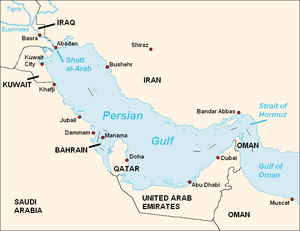| 2004 Iranian seizure of Royal Navy personnel | |||||||
|---|---|---|---|---|---|---|---|
 Two British patrol boats just after their capture as shown by Iranian TV | |||||||
| |||||||
| Belligerents | |||||||
|
|
| ||||||

On 21 June 2004, in the Shatt al-Arab (Arvand Rud in Persian) waterway,[1] six Royal Marines and two Royal Navy sailors were captured by Iran. The British servicemen were seized while training Iraqi river patrol personnel after Iran said they had strayed to the Iranian side of the waterway. They were threatened with legal action initially but released three days later following diplomatic discussions between Jack Straw, then British Foreign Secretary, and Kamal Kharazi, then Iranian Minister of Foreign Affairs. The weapons and boats of the British personnel were confiscated and have not been returned.[2]
They were released unharmed three days later, on 24 June, after the British and Iranian governments agreed there had been a misunderstanding[how?]. Their equipment was not returned and a rigid inflatable boat (RIB) was put on display in a museum in Tehran. During their detention, according to former detainee Marine Scott Fallon, they endured a mock execution in which they were marched into the desert and made to stand blindfolded in front of a ditch while their captors cocked their weapons.[3][4] They also appeared blindfolded on Iranian TV, where they were forced to apologise for their "mistake".[5][6][7] The Royal Navy boats were operating close to the northern coast of the Persian Gulf in the mouth of the Shatt al-Arab waterway which divides southern Iran and Iraq. The weather was bad causing negligible visibility which may have contributed to a potential crossing of the Iranian border by the Royal Navy. After the crew were returned and events analysed the British government affirmed its belief that the personnel were actually still in Iraqi waters, however they consigned the incident to a misunderstanding and requested the return of the equipment. In 2015, an FOIA request released a redacted report.[8][9]
- ^ "Timeline: UK-Iran relations". BBC News. 23 March 2007. Retrieved 28 March 2007.
- ^ "Iran releases British servicemen". BBC News. 24 June 2004. Retrieved 4 April 2007.
- ^ "Iraq urges Iran to free sailors". BBC News. 26 March 2007. Archived from the original on 31 March 2007. Retrieved 27 March 2007.
- ^ "Iran warns sailors may be charged". BBC News. 26 March 2007. Archived from the original on 27 March 2008. Retrieved 26 March 2007.
- ^ "Diplomats meet over Iranian seizure of British sailors". CNN. 23 March 2007. Archived from the original on 26 March 2007. Retrieved 23 March 2007.
- ^ "Iran holds British sailors as West set to tighten sanctions". AFP. 23 March 2007. Archived from the original on 30 September 2007. Retrieved 24 March 2007.
- ^ "Iran vows to release British servicemen". Edinburgh Evening News. 23 June 2004. Archived from the original on 10 May 2007. Retrieved 25 March 2007.
- ^ "Shaat Al Arab Learning Account" (PDF). Ministry of Defence. Retrieved 22 May 2016.
- ^ "Shaat Al Arab Learning Account supplementary paper" (PDF). Ministry of Defence. Retrieved 22 May 2016.